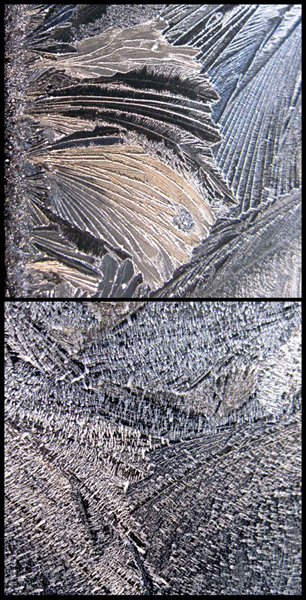First Frost
December 15th, 2009Here in this neighborhood of Japan, we finally had our first good frost day. By frost, I mean any ice that forms from vapor that condenses (wet or dry) onto a surface. We rarely get snow, typically just one or two short-lived, wet snowfalls over winter, but we often get frost. Frost might be common here because the temperature just dips a little below freezing (0 degrees Celcius), winter skies are often clear, and the humidity is high. For example, in my yard, about seven feet above ground (where I have a safe place for my temperature/humidity meter), the relative humidity last night stayed between 80 and 87% and the air temperature got down to 1.6 Celcius. But the temperature on surfaces exposed to the sky got colder. For example, on some metal plates I put in our carport, the temperature reached -6.0 Celcius. Roofs of cars parked in a more exposed area probably got even colder. The pictures below show frost from two black car roofs.
These pictures show a mixture of two types of frost: windowpane, or film, frost, which is often clear and curvy, and hoar frost, which is white and straight. Film frost grows along the surface; hoar grows out of the surface. For the snow crystal fan who lives in a place with little snow, hoar frost is the next best thing. I say this because hoar grows just like snow - sometimes like a branch of a thin star and sometimes like a column. Film frost is ice that grows in a thin film of liquid water that condensed like dew on the surface. For reasons that remain mysterious, film frost usually curves. After the liquid in the film crystallizes, hoar crystals sprout off the ice, growing upward, away from the surface. In the top image, hoar has just started, but enough has grown to make the curved ice white, in good contrast with the black surface below. In the bottom image, if you look closely, you can see the stubble of hoar whiskers growing as tiny ice columns off the surface (at this magnification, it is hard to determine if the hoar consists of columns or thin-star branches).
The thing that is totally bizzare about film frost is that the ice not only curves, but each curve consists of a crystal structure that twists. Hoar and snow do not twist. To picture what I mean by twist, imagine holding a huge snow star and twisting each branch in such a way that the crystal resembles a six-blade propeller. Real snow doesn't twist, but film frost does. Because the hoar grows off the twisting ice, the hoar columns tilt differently in different regions. You can see this if you look closely at the bottom image.

